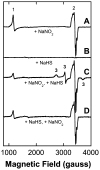Antagonism of Acute Sulfide Poisoning in Mice by Nitrite Anion without Methemoglobinemia
- PMID: 25951111
- PMCID: PMC5555412
- DOI: 10.1021/acs.chemrestox.5b00015
Antagonism of Acute Sulfide Poisoning in Mice by Nitrite Anion without Methemoglobinemia
Abstract
There are currently no FDA-approved antidotes for H2S/sulfide intoxication. Sodium nitrite, if given prophylactically to Swiss Webster mice, was shown to be highly protective against the acute toxic effects of sodium hydrosulfide (∼LD40 dose) with both agents administered by intraperitoneal injections. However, sodium nitrite administered after the toxicant dose did not detectably ameliorate sulfide toxicity in this fast-delivery, single-shot experimental paradigm. Nitrite anion was shown to rapidly produce NO in the bloodstream, as judged by the appearance of EPR signals attributable to nitrosylhemoglobin and methemoglobin, together amounting to less than 5% of the total hemoglobin present. Sulfide-intoxicated mice were neither helped by the supplemental administration of 100% oxygen nor were there any detrimental effects. Compared to cyanide-intoxicated mice, animals surviving sulfide intoxication exhibited very short knockdown times (if any) and full recovery was extremely fast (∼15 min) irrespective of whether sodium nitrite was administered. Behavioral experiments testing the ability of mice to maintain balance on a rotating cylinder showed no motor impairment up to 24 h post sulfide exposure. It is argued that antagonism of sulfide inhibition of cytochrome c oxidase by NO is the crucial antidotal activity of nitrite rather than formation of methemoglobin.
Conflict of interest statement
The authors declare no competing financial interest.
Figures






Similar articles
-
Acute, sublethal cyanide poisoning in mice is ameliorated by nitrite alone: complications arising from concomitant administration of nitrite and thiosulfate as an antidotal combination.Chem Res Toxicol. 2011 Jul 18;24(7):1104-12. doi: 10.1021/tx2001042. Epub 2011 May 11. Chem Res Toxicol. 2011. PMID: 21534623 Free PMC article.
-
Comparison of the relative propensities of isoamyl nitrite and sodium nitrite to ameliorate acute cyanide poisoning in mice and a novel antidotal effect arising from anesthetics.Chem Res Toxicol. 2013 May 20;26(5):828-36. doi: 10.1021/tx400103k. Epub 2013 Apr 19. Chem Res Toxicol. 2013. PMID: 23536974 Free PMC article.
-
Antagonism of cyanide toxicity by isosorbide dinitrate: possible role of nitric oxide.Toxicology. 1995 Dec 15;104(1-3):105-11. doi: 10.1016/0300-483x(95)03152-6. Toxicology. 1995. PMID: 8560488
-
The mechanism of cyanide intoxication and its antagonism.Ciba Found Symp. 1988;140:232-43. doi: 10.1002/9780470513712.ch14. Ciba Found Symp. 1988. PMID: 3073059 Review.
-
Recent perspectives on the toxicodynamic basis of cyanide antagonism.Fundam Appl Toxicol. 1984 Apr;4(2 Pt 2):S231-9. doi: 10.1016/0272-0590(84)90157-x. Fundam Appl Toxicol. 1984. PMID: 6327443 Review.
Cited by
-
Neurological Sequelae of Acute Hydrogen Sulfide Poisoning: A Literature Review, Controversies, and Knowledge Gaps.Neurol Int. 2025 May 6;17(5):71. doi: 10.3390/neurolint17050071. Neurol Int. 2025. PMID: 40423227 Free PMC article. Review.
-
Antidotal Action of Some Gold(I) Complexes toward Phosphine Toxicity.Chem Res Toxicol. 2019 Jun 17;32(6):1310-1316. doi: 10.1021/acs.chemrestox.9b00095. Epub 2019 May 16. Chem Res Toxicol. 2019. PMID: 31070361 Free PMC article.
-
A rapid evaluation of acute hydrogen sulfide poisoning in blood based on DNA-Cu/Ag nanocluster fluorescence probe.Sci Rep. 2017 Aug 29;7(1):9638. doi: 10.1038/s41598-017-09960-1. Sci Rep. 2017. PMID: 28852006 Free PMC article.
-
Midazolam Efficacy Against Acute Hydrogen Sulfide-Induced Mortality and Neurotoxicity.J Med Toxicol. 2018 Mar;14(1):79-90. doi: 10.1007/s13181-017-0650-4. Epub 2018 Jan 9. J Med Toxicol. 2018. PMID: 29318511 Free PMC article.
-
[Cardiac arrest under special circumstances].Notf Rett Med. 2021;24(4):447-523. doi: 10.1007/s10049-021-00891-z. Epub 2021 Jun 10. Notf Rett Med. 2021. PMID: 34127910 Free PMC article. Review. German.
References
-
- Adkins J. Hydrogen Sulfide Suicide: Latest Technique Hazardous to First Responders and the Public. Regional Organized Crime Information Center Special Research Report, Bureau of Justice Assistance, U.S. Department of Justice; Washington, DC: 2010.
-
- Ellenhorn MJ, Barceloux DG. Medical Toxicology: Diagnosis and Treatment of Human Poisoning. Elsevier; New York: 1988.
Publication types
MeSH terms
Substances
Grants and funding
LinkOut - more resources
Full Text Sources
Other Literature Sources

